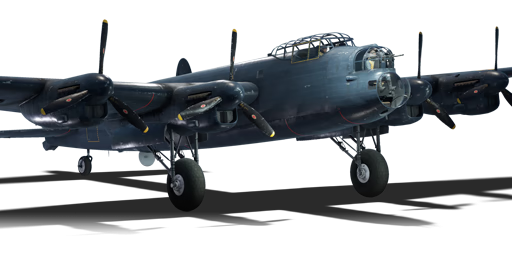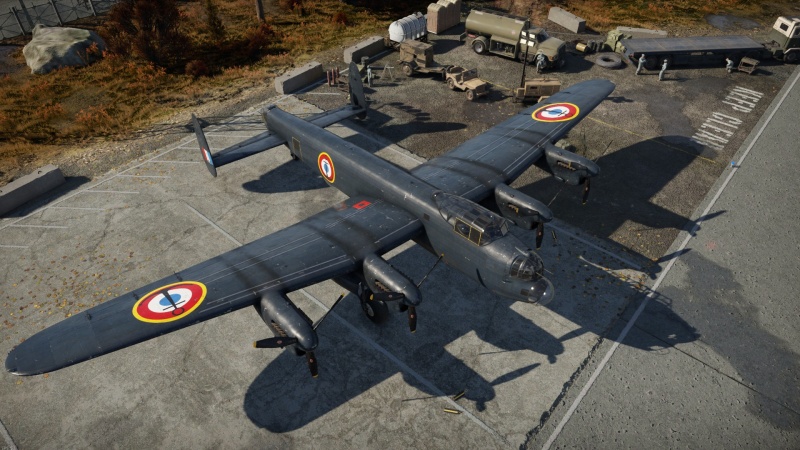Difference between revisions of "Lancaster MR.7"
Jareel_Skaj (talk | contribs) m (typo) |
m (Fixed a spelling mistake) (Tag: Visual edit) |
||
| Line 161: | Line 161: | ||
* Very heavy bombloads | * Very heavy bombloads | ||
* Powerful engines provides good acceleration and endurance | * Powerful engines provides good acceleration and endurance | ||
| − | * Overall very | + | * Overall very maneuverable, despite the size |
* Has an engine fire system to extinguish engine fires | * Has an engine fire system to extinguish engine fires | ||
* Can be used as an ad-hoc fast bomber due to its high wing rip speed | * Can be used as an ad-hoc fast bomber due to its high wing rip speed | ||
Revision as of 21:40, 15 June 2024
| This page is about the French bomber Lancaster MR.7. For other versions, see Lancaster (Family). |
Contents
Description
After World War II, many Lancaster bombers were refitted into civilian roles, such as transport, mail delivery, and search and rescue. 59 Lancaster B.Is and B.VIIs were ordered by the French Aéronavale to be converted into a maritime patrol aircraft. The aircraft, later designated Lancaster MR.7, were delivered by Avro during 1952-53. These would be the last direct variant of the Lancaster ever built. The MR.7 flew until the mid-1960s by four squadrons stationed in France and New Caledonia in the maritime reconnaissance and search-and-rescue roles.
It was introduced in Update "La Royale". The Lancaster MR.7 in the French tech tree is not identical at all to the Lancaster in the British tech tree. While it still carries a very large payload, enough to deal with a base in air battles and carpet bomb a good chunk of the map, this one has a more limited defensive armament that covers only the back and front of the aircraft. It also has access to a radar. However, the main difference is its inability to carry the 12,000 lb bomb found on the British Lancasters, in fact, its largest bomb is a 1,000 lb bomb, paired with more smaller bombs in the bomb bay.
General info
Flight performance
The aircraft has a great flight performance, a high wing rip speed and is a friendly take-off and landing aircraft.
| Characteristics | Max speed (km/h at 3,048 m) |
Max altitude (metres) |
Turn time (seconds) |
Rate of climb (metres/second) |
Take-off run (metres) | |||
|---|---|---|---|---|---|---|---|---|
| AB | RB | AB | RB | AB | RB | |||
| Stock | 447 | 434 | 7620 | 49.2 | 50.3 | 6.9 | 6.8 | 750 |
| Upgraded | 476 | 462 | 47.0 | 48.7 | 10.4 | 8.6 | ||
Details
| Features | ||||
|---|---|---|---|---|
| Combat flaps | Take-off flaps | Landing flaps | Air brakes | Arrestor gear |
| ✓ | ✓ | ✓ | X | X |
| Limits | ||||||
|---|---|---|---|---|---|---|
| Wings (km/h) | Gear (km/h) | Flaps (km/h) | Max Static G | |||
| Combat | Take-off | Landing | + | - | ||
| 608 | 338 | 415 | 318 | 282 | ~4 | ~3 |
| Optimal velocities (km/h) | |||
|---|---|---|---|
| Ailerons | Rudder | Elevators | Radiator |
| < 400 | < 350 | < 350 | > 350 |
Survivability and armour
- 8 mm Steel plates behind the pilot seat
- 6.35 mm Steel plate behind the engines
- No armour glazing
- Critical components located at the front of aircraft (fuel, pilot, engine, controls)
- More fuel tanks located in wings
Modifications and economy
Armaments
Suspended armament
The Lancaster MR.7 can be outfitted with the following ordnance:
- 14 x 250 lb M.C. Mk.I bombs (3,500 lb total)
- 6 x 500 lb M.C. Mk.I bombs + 8 x 250 lb M.C. Mk.I bombs (5,000 lb total)
- 14 x 500 lb M.C. Mk.I bombs (7,000 lb total)
- 6 x 500 lb M.C. Mk.I bombs + 1 x 1,000 lb M.C. Mk.I bomb + 2 x 250 lb M.C. Mk.I bombs (4,500 lb total)
- 6 x 1,000 lb M.C. Mk.I bombs + 3 x 250 lb M.C. Mk.I bombs (6,750 lb total)
- 14 x 1,000 lb M.C. Mk.I bombs (14,000 lb total)
Defensive armament
The Lancaster MR.7 is defended by:
- 2 x 7.7 mm Browning machine guns, nose turret (1,000 rpg = 2,000 total)
- 2 x 12.7 mm M2 Browning machine guns, tail turret (2,500 rpg = 5,000 total)
Usage in battles
Air Battles
The best use of the Lancaster MR.7 is to fly at high altitudes, destroy the target bases with its massive payload.
It is recommended to spawn at the long-range bomber spawn (normally 4,510 m) and as soon as you spawn you can climb between 5-10 degrees at 220-280 km/h IAS, by climbing at the angle of 5° you can get to the drop point in 4 to 5 minutes at almost 5,800 m. After you drop the bombs on the targets you should return to your airfield on a gentle descent of 15°.
If an enemy airplane is approaching, you should turn your back toward it (where the 2 x 12.7 mm machine guns are located), wait for it to get within 1 km of you and then begin to shoot him. If the enemy is approaching you from below or from above, pitch up or pitch down to get the best angle for your gunner.
If you are stock, the best loadout is the 14 x 500 lb bombs, with this loadout you can destroy 1 base and damage a second one (on a 4-base map 10 x 500 lb bombs per base and on a 3-base map 6 x 500 lb bombs per base). However, if you have researched the AUBC No.1 Mark II mod the best loadout is the 14 x 1,000 lb bombs. With this loadout, you can destroy 2 bases (on a 4-base map 7 x 1,000 lb bombs per base and on a 3-base map 4 x 1,000 lb bombs per base).
Mixed battles
The best use of the Lancaster MR.7 is to carpet bomb with its massive 14 x 1,000 lb payload.
- Spawn with the Lancaster MR.7 with the 14 x 1,000 lb payload
- Maintain any altitude you want, it just needs to be higher than 140 m from the ground (shrapnel radius of your bomb), it is recommended to fly high because of machine gun fire and SPAAs
- Drop your bombs on the enemy
- Get back to the airfield to reload
- Rinse and repeat
Manual Engine Control
| MEC elements | ||||||
|---|---|---|---|---|---|---|
| Mixer | Pitch | Radiator | Supercharger | Turbocharger | ||
| Oil | Water | Type | ||||
| Not controllable | Controllable Not auto controlled |
Controllable Auto control available |
Controllable Auto control available |
Separate | Controllable 2 gears |
Not controllable |
Pros and cons
Pros:
- Very heavy bombloads
- Powerful engines provides good acceleration and endurance
- Overall very maneuverable, despite the size
- Has an engine fire system to extinguish engine fires
- Can be used as an ad-hoc fast bomber due to its high wing rip speed
Cons:
- Relatively slow for the engines that it has
- Very weak and large airframe, its tail in particular can be easily destroyed by autocannons
- No armour behind the gunners
- No turret coverage below or above
- 7.7 mm MGs deal very little damage
- Lacks access to the more powerful bombs of the British counterpart
History
Describe the history of the creation and combat usage of the aircraft in more detail than in the introduction. If the historical reference turns out to be too long, take it to a separate article, taking a link to the article about the vehicle and adding a block "/History" (example: https://wiki.warthunder.com/(Vehicle-name)/History) and add a link to it here using the main template. Be sure to reference text and sources by using <ref></ref>, as well as adding them at the end of the article with <references />. This section may also include the vehicle's dev blog entry (if applicable) and the in-game encyclopedia description (under === In-game description ===, also if applicable).
Media
Excellent additions to the article would be video guides, screenshots from the game, and photos.
See also
Links to the articles on the War Thunder Wiki that you think will be useful for the reader, for example:
- reference to the series of the aircraft;
- links to approximate analogues of other nations and research trees.
External links
Paste links to sources and external resources, such as:
- topic on the official game forum;
- other literature.
| Avro Aircraft | |
|---|---|
| Bombers | Lancaster B Mk I · Lancaster B Mk III · Lincoln B Mk II · Shackleton MR.Mk.2 |
| Export/Licensed | Lancaster MR.7 |
| France bombers | |
|---|---|
| Farman | F.222.2 · N.C.223.3 |
| Latécoère | Late 298D |
| Potez | Potez 633 |
| Liore et Olivier | LeO 451 early · LeO 451 late |
| Bloch | M.B.174A-3 · M.B.162 · M.B.175T |
| American | V-156-F · Martin 167-A3 · ▄A-35B · ▄SB2C-5 · B-26C · ▄PBY-5A Late · ▄PB4Y-2 |
| British | Lancaster MR.7 |





